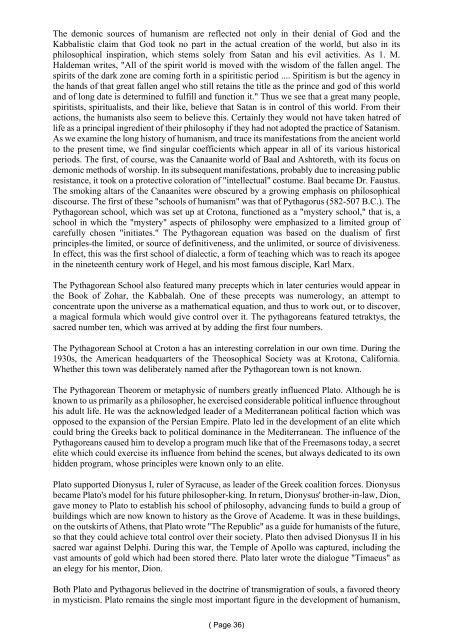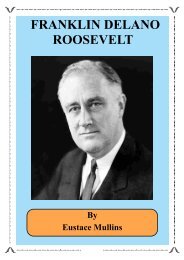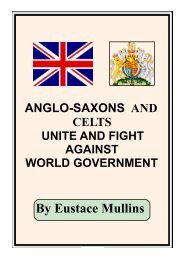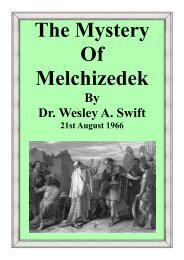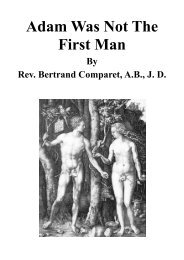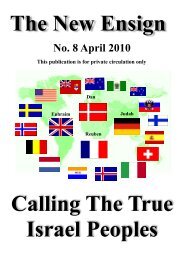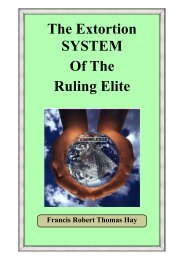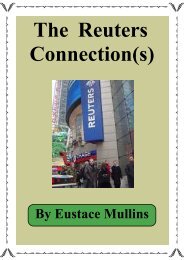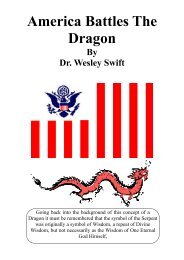Curse of Cannan - The New Ensign
Curse of Cannan - The New Ensign
Curse of Cannan - The New Ensign
Create successful ePaper yourself
Turn your PDF publications into a flip-book with our unique Google optimized e-Paper software.
<strong>The</strong> demonic sources <strong>of</strong> humanism are reflected not only in their denial <strong>of</strong> God and the<br />
Kabbalistic claim that God took no part in the actual creation <strong>of</strong> the world, but also in its<br />
philosophical inspiration, which stems solely from Satan and his evil activities. As 1. M.<br />
Haldeman writes, "All <strong>of</strong> the spirit world is moved with the wisdom <strong>of</strong> the fallen angel. <strong>The</strong><br />
spirits <strong>of</strong> the dark zone are coming forth in a spiritistic period .... Spiritism is but the agency in<br />
the hands <strong>of</strong> that great fallen angel who still retains the title as the prince and god <strong>of</strong> this world<br />
and <strong>of</strong> long date is determined to fulfill and function it." Thus we see that a great many people,<br />
spiritists, spiritualists, and their like, believe that Satan is in control <strong>of</strong> this world. From their<br />
actions, the humanists also seem to believe this. Certainly they would not have taken hatred <strong>of</strong><br />
life as a principal ingredient <strong>of</strong> their philosophy if they had not adopted the practice <strong>of</strong> Satanism.<br />
As we examine the long history <strong>of</strong> humanism, and trace its manifestations from the ancient world<br />
to the present time, we find singular coefficients which appear in all <strong>of</strong> its various historical<br />
periods. <strong>The</strong> first, <strong>of</strong> course, was the Canaanite world <strong>of</strong> Baal and Ashtoreth, with its focus on<br />
demonic methods <strong>of</strong> worship. In its subsequent manifestations, probably due to increasing public<br />
resistance, it took on a protective coloration <strong>of</strong> "intellectual" costume. Baal became Dr. Faustus.<br />
<strong>The</strong> smoking altars <strong>of</strong> the Canaanites were obscured by a growing emphasis on philosophical<br />
discourse. <strong>The</strong> first <strong>of</strong> these "schools <strong>of</strong> humanism" was that <strong>of</strong> Pythagorus (582-507 B.C.). <strong>The</strong><br />
Pythagorean school, which was set up at Crotona, functioned as a "mystery school," that is, a<br />
school in which the "mystery" aspects <strong>of</strong> philosophy were emphasized to a limited group <strong>of</strong><br />
carefully chosen "initiates." <strong>The</strong> Pythagorean equation was based on the dualism <strong>of</strong> first<br />
principles-the limited, or source <strong>of</strong> definitiveness, and the unlimited, or source <strong>of</strong> divisiveness.<br />
In effect, this was the first school <strong>of</strong> dialectic, a form <strong>of</strong> teaching which was to reach its apogee<br />
in the nineteenth century work <strong>of</strong> Hegel, and his most famous disciple, Karl Marx.<br />
<strong>The</strong> Pythagorean School also featured many precepts which in later centuries would appear in<br />
the Book <strong>of</strong> Zohar, the Kabbalah. One <strong>of</strong> these precepts was numerology, an attempt to<br />
concentrate upon the universe as a mathematical equation, and thus to work out, or to discover,<br />
a magical formula which would give control over it. <strong>The</strong> pythagoreans featured tetraktys, the<br />
sacred number ten, which was arrived at by adding the first four numbers.<br />
<strong>The</strong> Pythagorean School at Croton a has an interesting correlation in our own time. During the<br />
1930s, the American headquarters <strong>of</strong> the <strong>The</strong>osophical Society was at Krotona, California.<br />
Whether this town was deliberately named after the Pythagorean town is not known.<br />
<strong>The</strong> Pythagorean <strong>The</strong>orem or metaphysic <strong>of</strong> numbers greatly influenced Plato. Although he is<br />
known to us primarily as a philosopher, he exercised considerable political influence throughout<br />
his adult life. He was the acknowledged leader <strong>of</strong> a Mediterranean political faction which was<br />
opposed to the expansion <strong>of</strong> the Persian Empire. Plato led in the development <strong>of</strong> an elite which<br />
could bring the Greeks back to political dominance in the Mediterranean. <strong>The</strong> influence <strong>of</strong> the<br />
Pythagoreans caused him to develop a program much like that <strong>of</strong> the Freemasons today, a secret<br />
elite which could exercise its influence from behind the scenes, but always dedicated to its own<br />
hidden program, whose principles were known only to an elite.<br />
Plato supported Dionysus I, ruler <strong>of</strong> Syracuse, as leader <strong>of</strong> the Greek coalition forces. Dionysus<br />
became Plato's model for his future philosopher-king. In return, Dionysus' brother-in-law, Dion,<br />
gave money to Plato to establish his school <strong>of</strong> philosophy, advancing funds to build a group <strong>of</strong><br />
buildings which are now known to history as the Grove <strong>of</strong> Academe. It was in these buildings,<br />
on the outskirts <strong>of</strong> Athens, that Plato wrote "<strong>The</strong> Republic" as a guide for humanists <strong>of</strong> the future,<br />
so that they could achieve total control over their society. Plato then advised Dionysus II in his<br />
sacred war against Delphi. During this war, the Temple <strong>of</strong> Apollo was captured, including the<br />
vast amounts <strong>of</strong> gold which had been stored there. Plato later wrote the dialogue "Timaeus" as<br />
an elegy for his mentor, Dion.<br />
Both Plato and Pythagorus believed in the doctrine <strong>of</strong> transmigration <strong>of</strong> souls, a favored theory<br />
in mysticism. Plato remains the single most important figure in the development <strong>of</strong> humanism,<br />
( Page 36)


